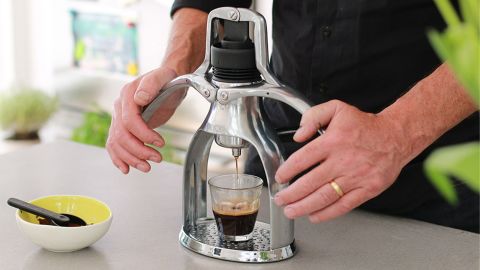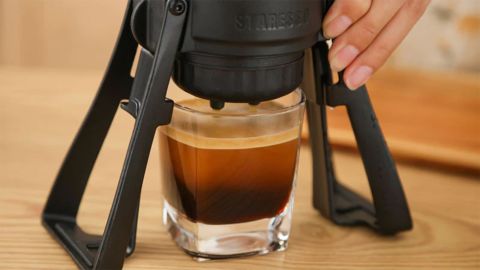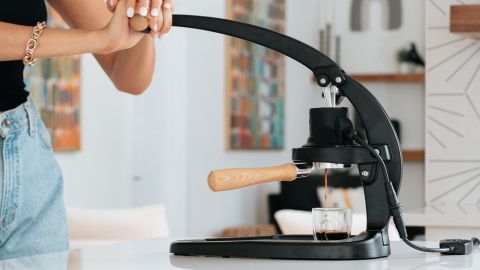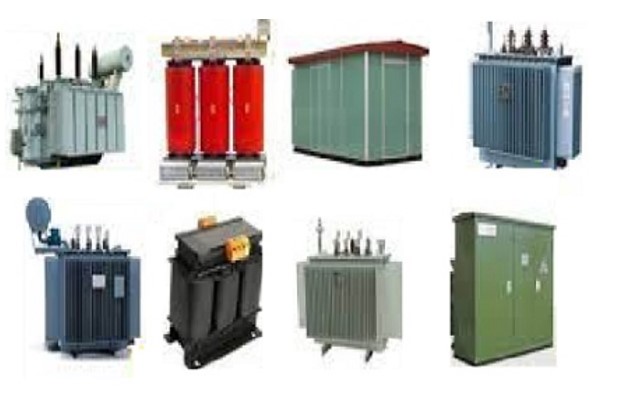The best manual espresso makers in 2022, tried and tested
You don’t need expensive equipment to make great espresso drinks, you just need well-designed, quality gear, the right coffee grind and some practice. Espresso machines are available to suit any kitchen, and a few manufactures have stripped the idea down to basics, producing machines that don’t even use boilers, relying on hand pressure to produce some pretty decent shots. With these manual espresso machines, you can have espresso wherever you like — on the road, in the office or even around the campfire.
We pulled dozens of shots with 10 leading countertop and portable manual espresso makers to find the simplest, best-designed, best-extracting and best crema-producing lever-driven espresso machines that are really worth your money.
The best manual espresso maker overall
With a simple, effective design that uses a traditional portafilter and holder, the easy-to-use Rok EspressoGC pulled high-quality shots with good crema — and it’s more affordable than its similarly designed competitors.
The best portable espresso maker
The Staresso Pro gave us the best results of the portable espresso makers we tested. It requires a little assembly and disassembly between shots, and takes some time to generate pressure, but the quality coffee is worth the effort.
Best manual espresso machine for coffee enthusiasts
The Flair 58 uses a commercial-style and -sized portafilter and electrical heating for stable temperatures over multiple shots, and with a little practice we were able to pull shots that rivaled those from machines costing hundreds — and even thousands — more.

If you aren’t looking to spend a lot of money and want a decent espresso, our choice would be the Rok EspressoGC. It edged out the very similar Cafelat Robot by virtue of its superior ease of use. With a little practice, you can produce an espresso shot that compares with what you’d pull using a medium-level consumer espresso machine, with a reasonable amount of crema in it.
Mounted on an oval base and supported by substantial metal legs, the squat central column of the Rok contains a piston and a water-loading chamber. Attached to that are two swing-out arms that resemble larger versions of those you’d find on a wing-style wine bottle opener; these operate the piston. The Rok features a mostly metal design, with a metal base, metal arms, a heavy metal portafilter with a plastic handle, and a plastic water chamber.
At the bottom of the column, you’ll find a brew head, and you load your coffee similarly to how you’d use a regular espresso machine, filling up the portafilter with finely ground coffee, tamping it (using a supplied plastic scoop-tamper-leveling tool) and locking it into place. The Rok’s well-built portafilter and removable basket attach using a familiar bayonet mount and are similar to those in consumer-grade espresso machines that you might find from Delonghi or Breville, though in a relatively small 40-millimeter size.
Since there’s no boiler or pump, you pour boiling water into the top of the column, then pull up the arms to create vacuum pressure, and then press them downwards (after about 10 seconds of waiting for the grinds to infuse) to extract the coffee. It’s simple, and it works consistently.
After using it about half a dozen times, dialing in the grind and refining our level and tamp technique, we achieved consistent results from shot to shot. However, as with any espresso machine, we got better results from freshly ground coffee than from pre-ground — we felt that a tighter grind than the type of “espresso” coffee sold in supermarkets allowed us to get nicer and sweeter shots consistently. There’s not much to clean up; the portafilter is easy to knock the grinds out of and wash out with water.
If you like espresso and want a simple device that produces consistently good shots without requiring perfect technique, then the Rok is an excellent choice for your home kitchen or the office.

If you want to make sure you’ve got access to espresso wherever you go, the Staresso Pro is compact enough to take anywhere and can extract nice shots of sufficient volume to be worth its relatively modest price.
The body of the roughly bullet-shaped Staresso Pro includes three high-impact plastic parts: a lower portafilter/brew head holding the ground coffee with a removable metal filter basket, a metal-lined center chamber filled with boiling hot water and a cover that incorporates a plunger mechanism. To use the device, for each shot you want to pull, you’ll need to screw these parts together, place them on top of a folding plastic base and begin pumping — it’s not a set-and-forget appliance.
As with the larger Rok and Flair machines, you fill the chamber with boiling water. From there, it’s up to you to create the pressure necessary to produce espresso. In the case of the Staresso — which is smaller than our other recommendations — you’ll have to pump the plunger repeatedly to produce enough pressure. It requires quite a lot of pumps to get out the coffee, about 15-20 in our experience.
The wait is worth it, however, and we were quite pleased with the results we got from the Staresso, as the pumping action was able to produce enough pressure to produce a nice crema and extraction, and it loads and produces enough ground coffee and water volume for a generous double shot. However, you’ll need a tight coffee grind to get good results and it’s going to be best when it’s very fresh, so you’ll want to grind your own rather than use store-bought. Staresso does sell a handheld grinder for just this purpose.
So if you’re looking for a small, inexpensive espresso maker you can keep at the office, or take with you traveling or camping, the Staresso can keep you supplied with good quality shots with a little effort.

If you‘re a coffee enthusiast who wants true cafe-level espresso shots, and you already own or are interested in using the types of portafilters, tampers, levelers and other accessories used in a professional-level or prosumer espresso machine, but want to explore this new all-manual style of machine, the Flair 58 is for you. It’s the latest manual machine from Flair, who’ve been making similar devices like the Neo for a while.
You may be wondering why you should spend $575 on this device when you can buy an entry-level semi-automatic espresso machine for about that same price, such as a Gaggia or Breville. While the Flair is certainly expensive compared to other machines we looked at, it also gave us impressive results, pulling shots with very strong extraction and lots of crema. With a little practice, we pulled coffees that compared favorably not just with higher-end semi-automatics, but with traditional manual espresso machines (which include a boiler and start at around $1,000) like the classic La Pavoni, and even with far more expensive high-end machines.
The 58 differs from most other manual espresso machines in that it uses a standard-sized 58mm portafilter with a removable metal dispersion screen and a standard 58mm 22-gram double-shot filter basket, like a high-end semi-automatic espresso machine. (The supplied portafilter is a bottomless or “nude” version, the type preferred by baristas for ease of monitoring their shots.) This lets you use standard filter baskets and tampers and other tools, and lets the machine produce a generous shot.
The Flair 58 also has two features that you’d typically find only on boiler-driven machines: a manometer, or pressure gauge, and an electrical heater to stabilize the brew chamber temperature for shot consistency. You still need to pour boiling water into the Flair 58, you just get a more stable temperature if you’re pulling a couple of shots; there’s also a 58X model that forgoes the heater for about $100 less.
Using the device is a pleasant ritual. Once you grind your coffee into the portafilter, you tamp it down, top it with the dispersion screen and lock it into place under the piston. With the lever depressed, you begin to add hot water from your kettle, pull the lever up and continue to fill it until you see it reach the very top. Then you then push down on the lever, gradually, watching the manometer pressure rise to around 10 bar as coffee streams from the portafilter to the cup below.
With a little time spent dialing in our coffee grind and getting the hang of the lever action (which soon became muscle memory) we were pulling very well-extracted shots with impressive crema — shots that easily equalled those from far pricier machines we’ve teested.
The product is extremely well-built from finely machined metal parts, with wooden handles and a thermal jacket for the main piston. The fit and finish are what you’d expect from a high-end appliance, and it’s very easy to assemble and disassemble, requiring only three bolts and an included tool.
The Flair 58 is so nice to use and produces such good espresso that we could see using it in place of our high-end semiautomatic machine. If you don’t need a boiler for milk drinks (and even if you do, you could just pair a simple milk frother with the Flair) and you’re serious about your espresso, you could easily make this your daily driver.
A manual espresso maker is a lever- or hand-pumped mechanical device used to produce extracted strong coffee shots — espresso. Lever machines were key in making espresso popular throughout Italy and eventually worldwide, with Gaggia’s lever-driven machines making it possible to create the pressure needed to make good espresso in a device small enough to be installed in any cafe.
While traditional lever designs — such as still-popular machines from La Pavoni and Olympia — have boilers, allowing you to always be ready to go and providing steam pressure for milk drinks, these new machines are far more minimal.
The new wave of manual machines requires you to heat water separately in a kettle and pour into a vessel above the coffee grounds. You then raise a lever or otherwise activate a hand to draw the water into the brewing chamber to saturate the fine coffee grounds (a step known as pre-infusion), and then depress the lever or plunger to create pressure, forcing the water through the coffee grounds and into your cup below.
While most semi-automatic espresso machines use a portafilter holder that fits via a bayonet mount into the brew head, the machines we looked at for this review (save for the Flair 58, which uses a commercial-style portafilter system), had their own unique designs and shot-loading procedures.
These devices can make surprisingly good coffee, providing lower-cost alternatives to electric machines with integrated boilers and electromechanical pumps; a portable solution if you want to take your own shots wherever you go; or giving you a tactile, handcrafted way to make espresso that isn’t quite like anything else. As with any espresso machine, “dialing in” grinds for each device was very important in order to achieve a good extraction, and the results also varied depending on the coffee we used for testing due to roast levels and other factors such as bean origin.
Some of the models we tested are small enough to take with you for travel, camping or the office so you can make espresso anywhere you go. Typically, they can only produce a tiny espresso at a time, and their portafilters can only accommodate a few grams of very finely ground coffee, so you won’t be serving a big party. These smaller designs usually need to be disassembled and reassembled for each shot, so they have a bit of a learning curve.
If you intend to use one of these devices, you’ll need a source of boiling water (we recommend an electric kettle), and if you intend to use whole bean coffee, a coffee grinder, preferably a conical burr unit, which is capable of grinding coffee to the necessary fineness and comes in manual and electric models.
We dedicated an area of our home kitchen to test these devices, with whole-home water softening and a triple-stage under-sink water filtration system. For hot water, we used an electric kettle.
Although all of these devices allow for the use of pre-ground coffee, for consistency and best quality of results, we only chose to use fresh-ground, whole-bean coffee. We recommend the Baratza Virtuoso+ conical coffee grinder for everyday use.
We focused first on the quality of coffee production. We wanted to see a good production of crema and an even, strong coffee extraction with a consistent flow. In addition to sweet-tasting, the resulting espresso should also be nice and hot.
We also paid careful attention to ease of use — given the nonstandard approach taken by many of these machines, we made sure it was easy to tamp and load; pull the shot; and clean, teardown, rebuild and reset before each use. In addition, we checked out the materials each unit and its accessories (such as the portafilter and supplied tamper) were made of and assessed their quality. And where needed, we made sure it was easy to contact the manufacturer with questions or concerns.
AeroPress Original Coffee and Espresso Maker
The Aeropress has long been a favorite of traveling coffee aficionados because of its simplicity. ease of use and no-fuss maintenance. The syringe-like device doesn’t make “espresso” per se — it makes strong filter coffee, akin to what you’d get from a French press, but it’s great for anyone who wants a flavorful, substantial brew anywhere they might go.
The device is extremely easy to use, clean and reset between brews. You stick a paper filter in to the filter head, screw it onto one end of the main cylinder, scoop in loose-ground coffee, fill it with hot water and let it brew for about 90 seconds. (Unlike many of the devices we tested, it gave us good results with both pre-ground and freshly ground coffee.) Then you insert the plunger and depress it, dispensing directly into your cup. Cleaning is a matter of unscrewing the filter head and depressing the plunger the rest of the way, ejecting the puck into the compost. It’s super convenient, and really makes the Aeropress easy to use anywhere.
Made of BPA-free polypropylene, the main component is a simple tube with a screw-on black plastic filter cap at one end loaded with disposable paper filters, which can be ordered from Aeropress or Amazon for $15 in packs of 700. Third-party reusable metal filters are also available.
The Flair Neo is the little brother of the Flair 58 and incorporates many of the same design elements, including a high-quality metal base with a permanently mounted piston lever and a thick and heavy (albeit smaller) stainless steel piston that you pour water into before brewing. However, instead of using a standard 58mm portafilter like the Flair 58, it uses a proprietary 40mm silicone portafilter that has to be inserted into the piston cylinder, where it’s held in place by friction; you’ll have to disassemble and clean it out between shots. There is no simple lock-and-load action that allows it to be reset for repeated shots, and the entire piston has to be removed and cleaned out (you run it under water in the sink) before another shot can be pulled. It’s not complicated or super finicky like some of the handheld devices we looked at, but if you plan on making several shots in a row, the Rok or the Flair 58 would be better choices. It does, however, produce very nice quality and consistent shots with good crema once you have your technique perfected.
Like the Rok EspressoGC, the Cafelat is a piston-operated unit that uses swing-out arms to provide the leverage needed to drive the mechanical piston operation that brews the coffee. The frame is well-built and attractive, with a retro-futuristic design that will certainly be a conversation starter.
However, we didn’t think the Cafelat was as easy to use as the Rok. Instead of a standard portafilter design, the Cafelat uses a combination brew pot and portafilter unit, which you fill with hot water and then clamp to the bottom of the piston. We found the process overly fiddly, requiring a very steady hand, and didn’t feel the shots were any better than those we got from the less-expensive and simpler Rok EspressoGC.
Like Staresso, Wacaco makes a range of portable espresso makers for those who want a shot wherever they may go. Its three models, the Picopresso, the Nanopresso and the Minipresso — all of which we looked at — sport a very similar three-piece design, which includes a lower brew chamber with a small removable filter for finely ground coffee (8g for the Minipresso and Nanopresso, and 18g for the Picopresso), a central water vessel with an integrated hand pump, and a top cap.
All of these parts need to be tightly screwed together to ensure a good extraction and prevent leaks — which is easier said than done. While we had no major issues with the Staresso, which is of a similar design, we had consistent water leak issues with all three Wacaco units. The pumping action is also more difficult because the mechanism is integrated into the center vessel and it has to be done from the side, versus directly down from the top, as on the Staresso, which also comes with a stabilizing base. The tiny thimble-sized filter baskets on the Minipresso and Nanopresso are also difficult to load and tamp, and the amount of coffee extracted seems hardly worth the trouble. While we got comparable quality shots out of the Picopresso as we did the Staresso, we just felt the industrial design of the latter was much better, and the competing product was less expensive.








